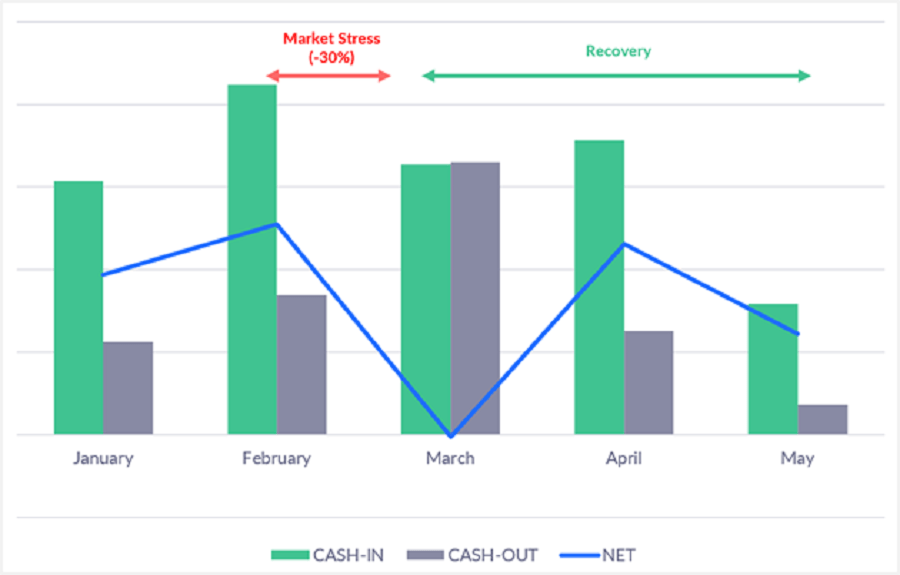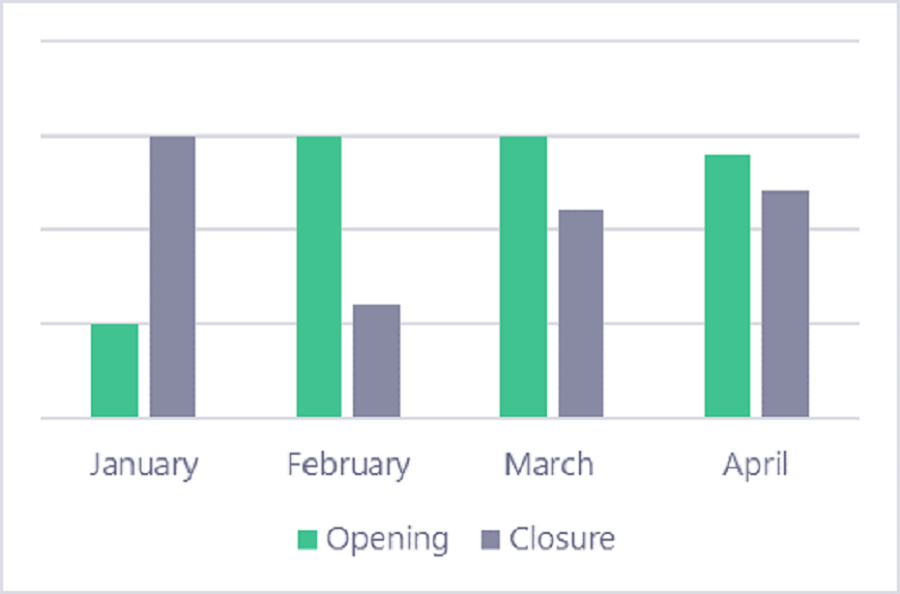Article by Ken Van Eesbeek, Head of R&D
When we launched Birdee - our B2C robo-advisor- in 2017, one of our main objectives was to get market insights from customers directly. With the feedback and insights of real users, we are able to build better solutions and live-tested technology to our B2B customers.
In a set of articles, we highlight some interesting statistics that could help other companies when starting an online advisory service.
This week: What was the impact of the COVID-19 crisis on customer behaviour?
Stating that COVID had and has a tremendous impact on people’s view on the future is like kicking down an open door. As usual, it is not the well-monitored risks that largest and lasting shocks in the market, but are the never-imagined scenarios that rule the headlines. Who would have predicted that a world-wide pandemic would be the event of 2020?
When confronted with an increased uncertainty, financial markets often react in a violent way. And more south than north. Common belief is that high volatility markets create an increase in loss aversion on the investor’s side, and consequently people flee towards more secure investments and cash. This increases risk aversion then tends to stay in the market for quite a while.
Little recap: what happened on the market after the COVID-19 outbreak?
Once it became abundantly clear that the virus would not stay contained in Asia, but would impact the world economy, markets panicked. Over the course of the last week of February and the first two weeks of March, stock markets lost more than 35% of their value. After reaching a bottom value mid-March - about the time that European countries started implementing quarantine measures - the trend reversed. By the beginning of June, about half of the loss was recuperated.
One might reason, that with that amount of market volatility and uncertainty, a lot of investors would shy away from financial markets.
How did the average investor react?
Quite surprisingly, a number of investment actors reported remarkable results. Schroders¹ for example, reported a 35% of investors raised their exposure during the crisis. Other research² showed a significant increase in trading activity, depository account opening and more stock and index positions. Also, our B2B customers -of which a lot of them are retail banks with a branch network- mentioned a significant increase in investor interest.
This begs the question; how did the clients of our B2C robo-advisor react? Birdee: Stable inflows, combined with Run-for-safety
For the behaviour of customers, we analysed 4 important figures: the inflows (subscriptions), the outflows (redemptions), and the number of account openings and closures.
A combination of stable inflows and larger outflows resulted in a net decrease of investment. This effect was however short-lived.
Looking at the cash inflows, the average Birdee investor did not seem to be hindered by the market turbulence. Quite some people did not change pace of investments, and took advantage of the lower market prices generated by the panic during March and April and increased their exposure. It is only as of May – when the market entered in recovery modus - that the inflows slowed down.
However, during March 2020, we noticed a significant increase in outflows (twice as high as the previous two months) following the market turbulence. In combination with stable inflows, this resulted in a drop of net inflows.
The following months – from April to June- these outflows went back to usual levels, even lower than average. During this period, the opportunity seekers outnumber the safety-seekers by a large majority over April, as well as the following months.
In sum, the COVID shock seemed to have alerted several customers, but the inflows kept stable compared to other months.

Cashflows per month
Not all investors are the same
The above numbers are however aggregate numbers and don’t provide the complete picture of customer behaviour.
It is important to know that the majority of Birdee customers have a dynamic risk profile. The customers with a more defensive risk profile, seem to react differently than their dynamic counterparts.
Indeed, defensive investors - who take less risk during normal time- tempt to also be the ones who disinvest during market stress.
Secondly, a lot of the people who disinvested in March, were the ones who re-invested in April or May. Their fear was in other words short-lived.
<10 %
of the customers asked for a redemption during the market shock.
Besides the global amounts, the number of investors asking money back, never exceeded 10% of the total client base.
Another interesting observation: almost nobody with a recurring investment plan -who almost always initiated an automatic transfer at their regular bank- cancelled those monthly subscriptions. Recurring investments are a very strong tool to ensure customer loyalty and generate a predictable AuM stream. We will come back to this in a future article.
No impact on contract closures
Besides the cashflows, the number of people opening or closing an account is also an indicator of how eager people are to invest.

Account openings and closures at Birdee
As for the account openings, Birdee registered a very stable flow of signatures over the period. It seems that the market volatility mainly had an impact on the market timing and thus the money flows, but not on the decision to open or close an account.
People stayed very loyal to their risk profile, proving that the profiling questionnaire is a solid measure for risk-aversion
The same goes for the number of people closing an account in February or March (right after the market crash), where we see no impact by the market turbulence.
Furthermore, a large majority of the closed accounts (+-80%) consisted of accounts that were opened over the proceeding 30 days. In other words, people who opened one or more accounts to test the service, but decided within the month that they prefer consolidating their money in 1 portfolio, or that investing is not for them. It comes as no surprise that loyalty has a momentum effect.
Only 3% of customers changed their risk profile.
People also remained very loyal to their risk profile and thus the risk level of the portfolio. Only 3% of people changed of risk profile, which is perfectly in line with observations during the same period the year before. This indicates that our risk profiling questionnaire is well capturing the risk-aversion of our customers, even during turbulent times.
Communication is key
Transparency and information are paramount. In times of uncertainty it is important to increase the outgoing communication towards your customers by a few notches. It is more convenient to be in contact with clients to confirm good performance, but it is essential to communicate with clients in times of market downturn. This comes obviously on top of the regulatory required communication.
+50%
incoming questions
During the first weeks of the break-out and confinement, Birdee increased its email and newsfeed frequency towards 1-2 messages per week. This includes an update on the condition of the financial markets, as well as the strategy of the investment committee to protect the money of the investors.
Secondly, it is important to prepare for a larger stream of incoming questions. At Birdee these interactions increased by approximately 50% over March and April. People expect, and deserve, a timely response, and guaranteeing reactivity has a crucial impact on the customer satisfaction. Most interactions were not panic reactions at all. A large majority were clarifications on market-timing (is this the right moment to invest?), the reasoning behind rebalancing processes and costs.
0
number of telephonic interactions
Surprisingly, there were no incoming requests via telephone; only via email and our chatbox. On the other hand, it might not be a surprise that robo-advisor customers are quite comfortable with digital interaction. In addition, the effect of lockdown and homework may also have played a role.
Conclusion
The reaction of Birdee investors to the COVID was very much balanced. Dynamic investors saw the drop in market prices as an opportunity and didn’t change the pace of inflows. Some defensive investors took a more “wait and see” attitude and temporarily disinvested. These effects were however short-lived.
Overall, we see that Birdee customers are in for the long-run, and therefore have a much more considerate reaction to market turbulence. Nonetheless, the importance of pro-active and regular communication is of paramount importance. The customer loyalty at Birdee is a living proof.
¹ https://www.schroders.com/en/uk/private-investor/insights/global-investor-study/market-shock-how-did-investors-react-to-the-impact-of-covid-19/ ² Regina Ortmann, Matthias Pelster and Sascha Tobias Wengerek, Finance Research Letters, https://doi.org/10.1016/j.frl.2020.101717
.svg)